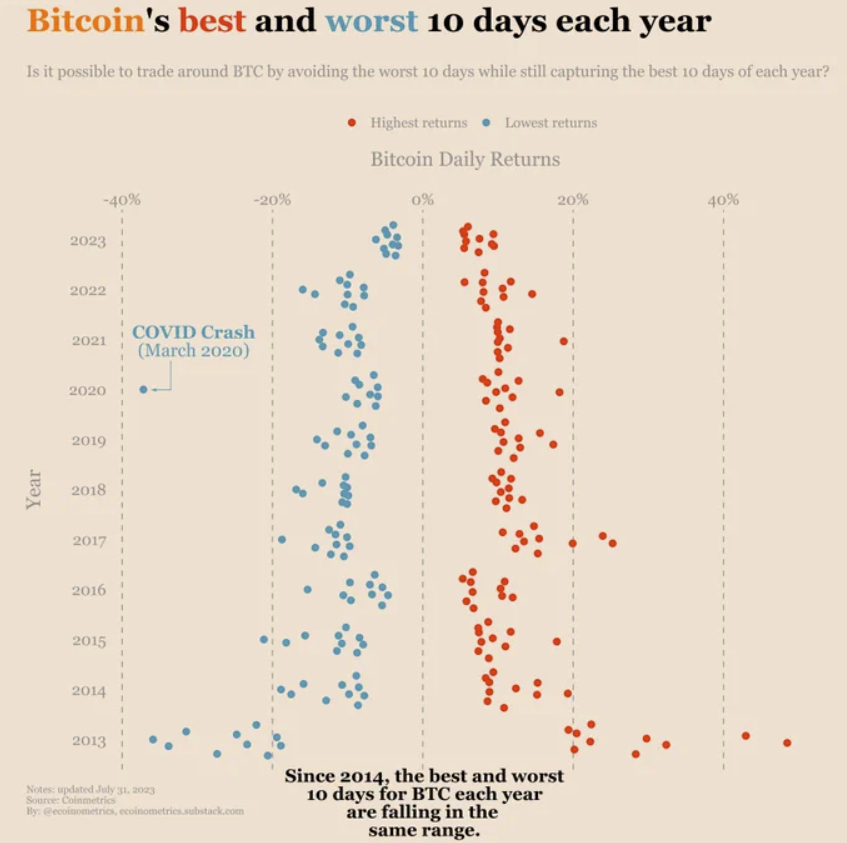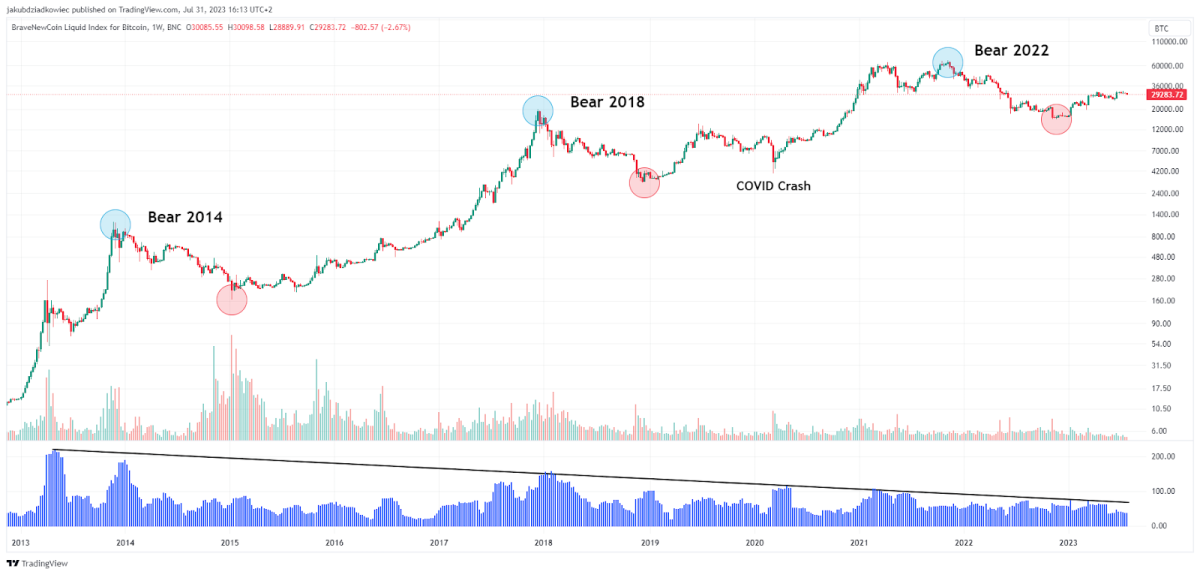Bitcoin (BTC), like most cryptocurrencies, has been subject to high volatility since its inception. It has earned a reputation as a great investment due to its potentially high return on investment. At the same time, it remains a risky asset as it regularly loses 75-85% of its value during cyclical bear markets. Data recently released by Ecoinometrics provides new insights into Bitcoin volatility. Contrary to popular perception, BTC volatility applies to bulls as well as bears. Metaphorically speaking, this suggests that Bitcoin is symmetrical, with its best and worst days often balancing each other out. Here are the details…
Bitcoin volatility is highly symmetrical
A chart posted on Twitter shows the Bitcoin price’s 10 best and worst trading days of each year since 2013. The horizontal scale ranges from -40% to +40% of daily profit or loss. The vertical scale shows consecutive years in order from bottom to top. The blue dots mark the days when BTC saw the lowest profit, i.e. the biggest daily drop. The further the point is to the left, the deeper the fall. The red dots represent the days when Bitcoin is the most profitable, that is, it increases the most on a daily basis. Naturally, profits increase as you move to the right.

The first thing that catches your eye after looking at the chart is its symmetrical shape. It resembles the shape of a Christmas tree or a wide-bottomed Coca-Cola bottle. The obvious interpretation of such a score distribution is reduced volatility. This applies to both potential profits and losses. In general, the deviation range from the mean value of 0% is smaller in each successive year. But this is not a monotonous decline. Because sometimes there are years that are more variable than previous years. A positive example of increasing returns can be seen in 2017, when the red dots crossed the +20% mark several times. This did not happen once for Bitcoin in 2014-2016. In contrast, a negative example is 2022, when negative volatility is higher than the entire 2019-2021 period.
There is a link to halving
Of course, both 2017 and 2022 are not accidental. They continue to be closely linked to Bitcoin’s 4-year halving cycles. 2017 was the second exponential part of the bull market, leading to a historic all-time high (ATH) of around $20,000. By contrast, 2022 was the latest cryptocurrency winter. This was the worst period since 2018, causing BTC to drop 77%.

The difference in local volatility and global symmetry draws attention
Despite these local imbalances, the entire chart of Bitcoin’s 10 best and worst 10 days in the last 10 years remains roughly symmetrical. This leads to two main consequences:
- Bitcoin remains an attractive asset for investors due to its equally high volatility for long (upside) and short (downward) positions.
- BTC volatility decreases over time as the market cap grows. More and more capital is required to move the market, so over time the Bitcoin market will likely resemble traditional financial markets.

The latter result is well illustrated by Bitcoin’s long-term chart on a logarithmic scale and the associated Historical Volatility (HV) indicator. Past cycles have mostly been characterized by maximum volatility at the end of a bull market and high volatility at the end of a bear market. Despite this, the blue HV chart is in a clear downtrend. The descending peaks follow the descending resistance line (black). This indicates that BTC volatility has decreased despite the ongoing 4-year halving cycle.
Extreme values and black swan events are also effective in Bitcoin price.
The reduced volatility can be seen by comparing the volatility in the first years Bitcoin was listed with the current volatility. The Christmas tree shape in the chart by Ecoinometrics shows that the more mature BTC as an asset, the lower the volatility will be expected. For example, 9 of the top 10 days in 2013 yielded returns above 20%. But during the 2017 bull market, this rate was only 3 out of 10 days. Since then – for 5.5 years – no trading day has yielded 20% Bitcoin returns.

The same is true for the worst days. Here, no trading day since 2015 has dropped more than -20%. The only exception is the black swan event in March 2020, when Bitcoin experienced a deep drop of almost 40%. cryptocoin.comAs we have reported, many other traditional assets also fell in the event in question.





